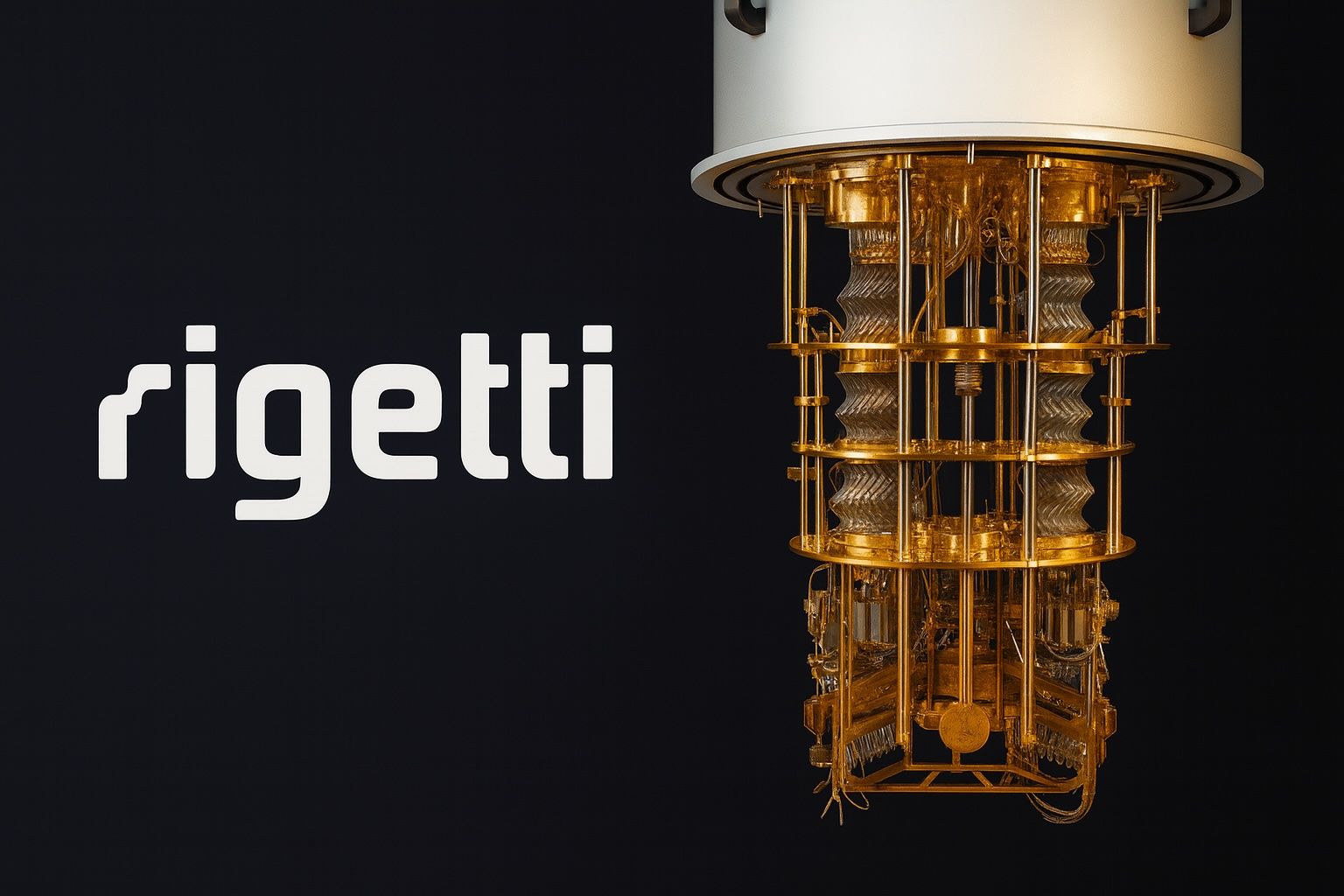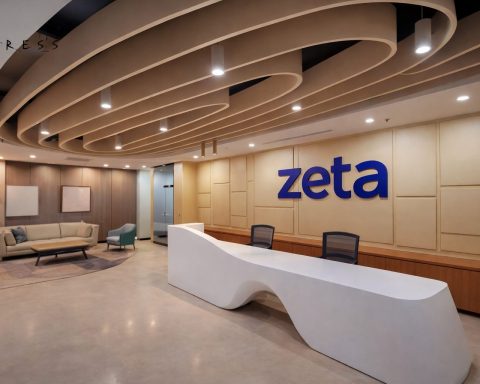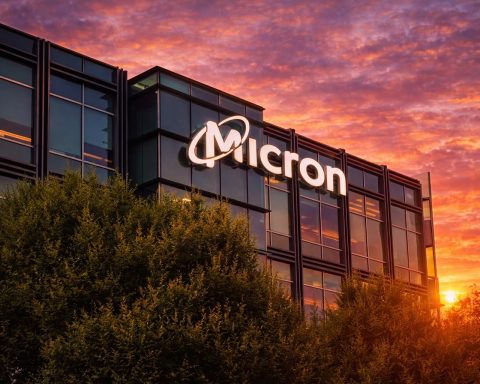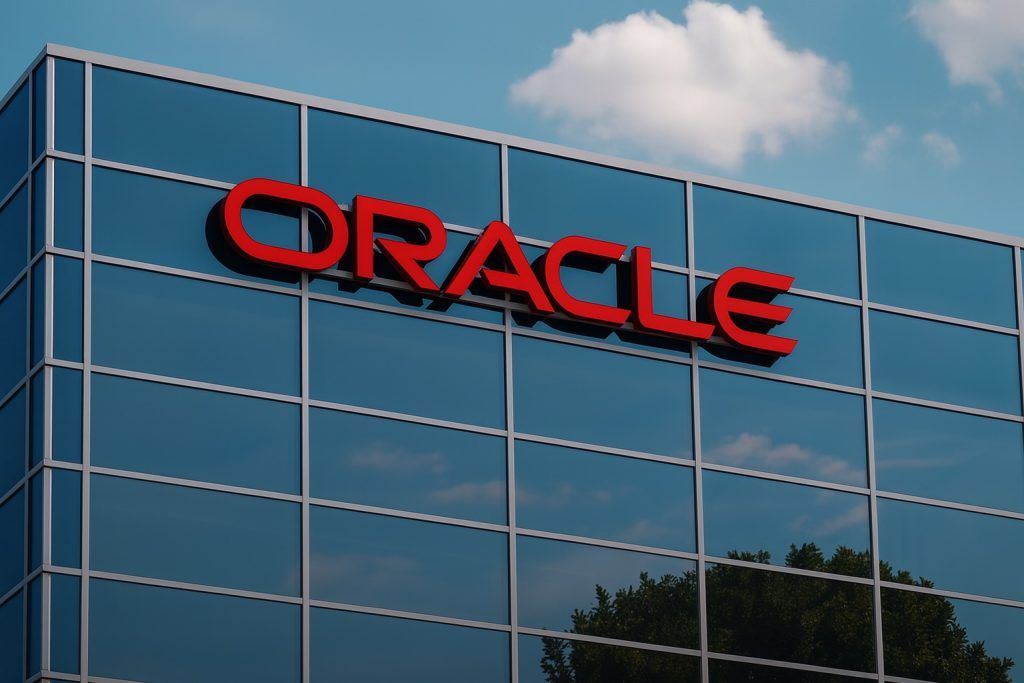- RGTI stock at record highs: Rigetti Computing’s share price surged to around $40 by October 6, 2025 – an all-time high (52-week high $40.63) [1]. The stock has rocketed over 80% in the past month (≈84% gain in September alone [2]), and ~127% year-to-date [3]. Remarkably, RGTI traded under $1 a year ago; its market cap now nears $13 billion [4] (up ~2,500% over 12 months [5]). Heavy trading volume and quantum computing hype have fueled this rally.
- Major contract wins fuel rally: In late September, Rigetti announced $5.7 million in orders for its Novera quantum computers and a $5.8 million U.S. Air Force contract – small sales that sparked big stock moves. The two Novera orders alone instantly boosted Rigetti’s market capitalization by $1.56 billion [6], underscoring immense investor optimism on modest deals.
- Cutting-edge tech & partnerships: Rigetti is advancing a “full-stack” quantum computing strategy. It rolled out a new 36-qubit multi-chip quantum processor (Cepheus-1) in 2025 with record 99.5% two-qubit fidelity [7], and it targets a 100+ qubit system by end-2025 [8]. The company inked strategic partnerships – e.g. a $100M+ collaboration with Quanta Computer (which invested $35M) to scale hardware [9], a memorandum with India’s C-DAC to co-develop hybrid quantum-classical systems [10], and placement of its first on-premises quantum computer at Montana State University [11] – signaling global interest.
- Financial snapshot – tiny revenue, big cash burn: Rigetti remains early-stage financially. Q2 2025 revenue was just $1.8 million (down ~42% YoY) against a net loss of $39.7 million [12]. Year-to-date revenue is under $3.5M, dwarfed by heavy R&D spending. Gross margins have eroded (31% vs 64% a year prior) [13]. However, Rigetti raised ~$385 million in Q2 (including a $350M at-the-market stock sale), ending June with $571.6 M cash and no debt [14] [15]. This war chest gives it a runway for development even as it burns ~$38M per quarter [16]. Analysts forecast full-year 2025 revenue of only ~$8–9 million [17], rising to ~$20M+ in 2026 – huge growth in percentage but small in absolute terms [18]. In short, current fundamentals don’t justify the $13B valuation [19] without significant future breakthroughs.
- Analysts bullish but wary: Wall Street coverage is generally positive on Rigetti’s long-term potential but flags near-term risks. All 6–7 analysts covering RGTI rate it a “Buy” or “Strong Buy” [20] [21]. However, the average 12-month price target is only ~$20–21 [22] [23] – roughly 50% below the current price, implying the stock may be overheated. Notably, B. Riley recently hiked its target to $35 (the Street high) citing Rigetti’s rapid tech advances [24], while others like Needham stay around ~$18–20 [25]. The upbeat thesis: Rigetti’s breakthroughs show that this “former frontier technology is rapidly advancing toward…commerciality” [26]. Yet skeptics highlight the valuation disconnect, with one commentator bluntly noting that a ~$10B–$13B market cap vs. only ~$8M revenue is extreme [27]. CNBC’s Jim Cramer cautioned “I don’t know whether Rigetti is worth what it’s trading at”, calling it a pure “speculation” play [28]. Another analyst likened RGTI to a “lottery ticket” – high-risk, high-reward [29].
- Investor sentiment & insider moves:Quantum fever has gripped retail traders – Rigetti’s rally has drawn meme-stock style buzz and FOMO in forums [30]. Every contract win or tech milestone has triggered spikes. At the same time, some insiders appear to be cashing in: Rigetti executives and directors sold millions in stock during the recent run-up [31] [32], and short interest sits around ~14% [33], indicating bets against the stock. Major institutions have also increased positions (e.g. Vanguard +60% in Q2) [34], reflecting a mix of long-term optimism and opportunism. The result is a market mood that balances excitement with caution [35] – many believe in quantum computing’s promise, but seasoned investors worry the stock’s momentum has outrun its current reality.
- Quantum industry context: Rigetti is one of only a few public pure-play quantum computing companies, alongside IonQ (IONQ) and D-Wave Quantum (QBTS). All have seen spectacular stock surges in 2025 amid a broader quantum tech boom. For instance, IonQ’s stock is up ~75% YTD (and ~700% YoY) and hit a ~$20B market cap [36] [37], while D-Wave’s is up ~165% YTD [38]. Yet their revenues remain minuscule: IonQ posted $20.7M Q2 revenue vs $20B valuation, D-Wave ~$3.1M vs $10B [39]. Rigetti’s ~$10–13B value vs $1.8M Q2 sales fits the pattern [40] – these stocks trade on long-term potential, not present financials. The entire quantum sector has outpaced the broader market in 2025 [41], buoyed by breakthroughs and investor speculation. Even tech giants (IBM, Google, Microsoft) are investing heavily in quantum R&D, lending credibility to the field, though those giants aren’t pure stock plays [42]. A Bank of America strategist recently called quantum computing “the most important technological race of our generation” [43], capturing why investors are pouring in despite the early stage.
Stock Performance: Skyrocketing to Record Highs
Rigetti Computing’s stock (NASDAQ: RGTI) has been on a tear, soaring to record levels heading into October 2025. On October 6, shares opened around $40.06 – essentially at all-time highs [44]. This price is astounding given RGTI traded below $1 at its low; in fact, the 52-week range spans $0.73 to $40.63 [45]. The quantum computing optimism in 2025 turned Rigetti from a penny stock into a multi-billion dollar company virtually overnight.
The rally really accelerated in September. Rigetti’s stock jumped 83–84% during September 2025 alone [46] – far outpacing other quantum peers and the flat broader market. After hovering around $15 through mid-year, RGTI started climbing in early September. Between September 12 and 19, it spiked from ~$16 to ~$28 (+70% in one week) [47]. It hit the $30s by late September, and on Oct 2 it surged 18.6% in a single day to close at $35.40 [48], with intraday highs above $35. That marked a new 52-week peak (intraday high $35.81 on Oct 2) amidst trading volume nearly 3× the norm [49]. The very next trading day, Oct 3, RGTI pushed even higher into the upper-$30s [50]. By early Oct, Rigetti’s share price was roughly double where it started 2025 [51], and up over 4,000% year-on-year (thanks in part to coming off a SPAC-era trough) [52].
Such explosive gains reflect intense speculative enthusiasm. Each positive headline seems to send the stock higher, amplified by social media buzz. As one report noted, Rigetti “soared to a fresh record high” on Oct 3 after news of its Novera orders hit the wires [53]. Retail traders have piled in, seeing RGTI as a way to ride the “next big thing” in tech. Momentum and FOMO (fear of missing out) are clearly at play – on Oct 2, more than 144 million RGTI shares traded (about 3× the average volume) [54] as buyers rushed to get a piece of the action.
It’s also notable that Rigetti’s surge has often lifted other quantum stocks in sympathy. When Rigetti announced major news, D-Wave jumped ~14% and IonQ ~10% in parallel [55], showing how investors see the sector moving as a pack. Year-to-date, Rigetti’s ~+127% climb [56] actually outperformed IonQ (+48% YTD) and D-Wave (+165% YTD) by early October [57]. Clearly, Rigetti has become one of 2025’s hottest tech stocks, greatly outpacing the S&P 500 and even most AI stocks. Its market capitalization swelling to $11–13 billion (from under $1B a year ago) exemplifies the speculative fervor around quantum computing.
However, this meteoric rise has also prompted warnings of volatility. After such a parabolic move, the stock has shown signs of tug-of-war: minor pullbacks and profit-taking whenever it hits new highs. Many observers note that Rigetti’s swings are driven more by sentiment than fundamentals – a classic hallmark of momentum trading. In short, RGTI’s recent performance has been spectacular but unstable, riding on news headlines and investor hopes. The key question is whether the company’s progress can ultimately justify this valuation, or if the stock is sprinting ahead of itself.
Recent News & Major Developments
Rigetti’s stock rally did not happen in a vacuum – it coincided with major company news that signaled progress in turning quantum computing from experiment into enterprise. In the weeks around its surge, Rigetti announced significant contracts, product milestones, and partnerships. These developments reinforced investor confidence (and media buzz) that Rigetti is moving toward commercial viability. Below are the key recent developments (late Q3 2025):
- New Customer Orders ($5.7M Novera Systems): On September 30, Rigetti revealed it secured purchase orders totaling ~$5.7 million for two of its Novera quantum computers [58]. These are 9-qubit, on-premises quantum processing units (upgradable in qubit count) aimed at research use. Notably, the buyers were not government agencies but commercial/academic customers: one is a large tech manufacturer in Asia, and the other a California AI/physics startup [59] [60]. Delivery is expected in the first half of 2026 [61]. While small in dollar terms, these sales are crucial as Rigetti’s first announced hardware orders from industry players. Analysts said the deal “reinforced investor confidence in Rigetti’s transition toward commercialization” [62]. Indeed, the stock jumped ~16–19% on the news [63]. Management acknowledged $5.7M is modest, but noted it’s significant relative to Rigetti’s tiny revenue base – roughly 72% of the company’s prior 12-month revenue [64]. CEO Subodh Kulkarni hailed the orders as evidence of “increased demand for on-premises quantum systems as the industry matures” [65].
- U.S. Air Force Contract ($5.8M for Quantum Networking): A couple weeks earlier, Rigetti announced a 3-year, $5.8 million contract with the U.S. Air Force Research Laboratory (AFRL) on September 18 [66]. Under this grant, Rigetti (in partnership with Dutch quantum networking startup QphoX) will develop superconducting quantum networking technology for the Air Force. In simple terms, they aim to link Rigetti’s superconducting qubit processors with optical photon networks, enabling quantum information to be transmitted over long distances [67]. Kulkarni called it “an exciting opportunity to advance superconducting quantum networking” by combining Rigetti’s qubit expertise with QphoX’s tech and AFRL’s capabilities [68]. Though $5.8M is also relatively small, government R&D awards like this validate Rigetti’s tech and provide non-dilutive funding. Investors took notice – Rigetti’s stock popped ~12% on the day of the AFRL contract news (mid-September) [69]. These wins show Rigetti can compete for prestigious federal projects, a positive signal for its credibility in the field.
- Technology Milestone – 36-Qubit “Cepheus” System: In August 2025, Rigetti reached an important technical benchmark by launching “Cepheus-1”, a new 36-qubit quantum processor that is comprised of 4 linked chiplets [70]. This multi-chip approach allowed Rigetti to quadruple its qubit count from prior 9-qubit generations, while halving two-qubit gate error rates (achieving 99.5% fidelity up from ~98%) [71]. The company touts Cepheus-1 as “the industry’s largest multi-chip quantum computer” currently available [72]. It has been deployed on Rigetti’s Quantum Cloud Services and will also be offered via Microsoft’s Azure Quantum cloud [73]. Kulkarni emphasized that scaling up qubits while improving fidelity is “the clear path towards quantum advantage” (the point where quantum computers solve problems beyond classical capability) [74]. This milestone demonstrates Rigetti’s technical prowess in integrating multiple superconducting chips – a different scaling strategy than competitor IonQ’s ion-trap approach. It’s also a stepping stone to the company’s goal of a 100+ qubit system by end of 2025 [75]. If Rigetti can deliver that 100-qubit chip (and ultimately achieve “quantum advantage” in coming years), it would be a game-changer. These R&D achievements, while not immediately profitable, underpin the long-term investment thesis and were cited by analysts as justification for optimism [76].
- Global Partnerships and Market Expansion: Rigetti has been actively forming partnerships to bolster its ecosystem and global reach:
- In February 2025, Rigetti entered a $100+ million strategic collaboration with Quanta Computer, a major Taiwan-based electronics manufacturer [77]. Quanta took a $35M equity stake in Rigetti and both companies committed R&D resources to accelerate development of Rigetti’s next-generation quantum hardware. Kulkarni said Quanta’s backing “will strengthen our leadership… and put us at the forefront of the industry” [78]. This partnership not only provided cash but also leverages Quanta’s manufacturing expertise as Rigetti looks toward eventually producing larger quantum systems at scale.
- In September 2025, Rigetti signed a memorandum of understanding with India’s C-DAC (Centre for Development of Advanced Computing) to co-develop hybrid high-performance computing (HPC) and quantum systems [79]. This collaboration aims to integrate Rigetti’s superconducting QPUs with India’s supercomputing infrastructure, creating “powerful and practical hybrid computing systems” for tasks like optimization and simulation [80]. It aligns Rigetti with India’s national quantum initiative and could open a new market, as India plans major investments in quantum tech.
- In August 2025, Rigetti deployed a Novera 9-qubit system at Montana State University (MSU), marking the first on-premises Rigetti quantum computer at an academic institution [81]. The Novera installation at MSU’s QCORE lab gives students and researchers hands-on access to Rigetti’s hardware for R&D on algorithms and error correction [82]. This is an important proof-point for Rigetti’s “quantum-in-a-box” offering for universities and labs, potentially seeding future commercial adoption.
Overall, the flurry of contracts, product launches, and alliances in late 2025 has kept Rigetti in the spotlight. These developments portray a company moving fast on multiple fronts – winning early customers, advancing its hardware, and teaming up with industry and government partners. In turn, this steady drumbeat of “good news” has been a key catalyst for the stock’s momentum. Financial media from Yahoo Finance to Nasdaq and Motley Fool highlighted how the ~$5.7M orders and Air Force deal “fueled” Rigetti’s sustained rally [83]. Each announcement reinforced the narrative that Rigetti is making tangible progress (even if revenues remain small). That narrative is crucial for maintaining investor enthusiasm in a pre-profit company.
However, it’s worth remembering that these deals are still modest in scale – e.g. two Novera sales and one government contract won’t fundamentally change Rigetti’s financial picture overnight. What they do is demonstrate demand and interest which, if continually built upon, could eventually lead to meaningful revenue. The stock’s dramatic reaction to these wins also underscores how much of Rigetti’s valuation is predicated on future potential rather than present results. That leads us to the financial reality check behind the excitement.
Financial Update: Early-Stage Metrics and Cash Runway
Despite its lofty market cap and surging stock, Rigetti’s financials reflect a company in the nascent, investment-heavy phase of its life cycle. The latest earnings data (Q2 2025) illustrate the point:
- Revenues remain minimal: Rigetti reported only $1.8 million in revenue for Q2 2025 [84], a ~42% decline from $3.1M in the year-ago quarter. For context, that’s less quarterly revenue than many small tech startups, highlighting that quantum computing is not yet a commercial at-scale business. The company’s revenue comes from research contracts and cloud access to its quantum processors – all relatively low-dollar pilot projects. In the first half of 2025, total revenue was about $3.3M, so full-year 2025 sales might land under $8–9M barring a major uptick [85]. (Indeed, analysts’ consensus for 2025 revenue is ~$8.3M [86].) By comparison, Rigetti’s stock valuation implies investors are looking far into the future when revenues could be orders of magnitude higher.
- Large ongoing losses: Running a quantum hardware R&D operation is expensive. Rigetti’s net loss in Q2 2025 was $39.7 million [87], roughly in line with recent quarters. Operating expenses (for research, engineering, chip fabrication, etc.) were about $20M for the quarter, vastly exceeding the $1.8M in sales [88]. The company’s net margins are deeply negative (-2,135%) [89] and it loses around $0.05–$0.06 per share each quarter [90]. These losses are typical for a pre-revenue tech firm investing heavily in growth, but they underscore that Rigetti will likely remain unprofitable for years. In fact, Wall Street forecasts project an EPS of about -$0.34 for full-year 2025 [91] and continued losses through the next couple of years. There is effectively no path to profitability in the near-term – any hope of breakeven is tied to achieving a quantum computing breakthrough and scaling revenue toward decade’s end (some analysts think ~2030 is the earliest for potential profits [92]).
- Declining margins (short-term): Not only is revenue tiny, but Rigetti’s gross profit margins have also shrunk as it scales up its engineering efforts. In Q2, gross margin was around 31% (down from ~64% a year prior) [93]. This drop was due to higher costs of providing quantum services and underutilization of expensive infrastructure (like its fab and cloud) relative to the low sales. In other words, Rigetti’s few million in revenue aren’t covering the fixed costs of its cutting-edge operations, so margins are temporarily low or negative. This isn’t alarming for now – if the company succeeds in selling more systems/cloud usage, margins should improve – but it reinforces that current revenues can’t support the operating platform.
- Robust cash position (thanks to dilution): On the positive side, Rigetti has amassed a significant cash war chest to fund its mission. By June 30, 2025, the company held $571.6 million in cash and equivalents [94] with zero debt [95]. This was achieved by tapping equity markets: in Q2, Rigetti raised ~$350M through an at-the-market stock offering (issuing new shares gradually into the market) [96], and earlier in 2025 it received a $35M strategic investment from Quanta Computer [97]. The result is that Rigetti’s balance sheet is very strong for a company its size – it has more than half a billion dollars to cover ongoing R&D and capital expenditures. At the current burn rate (~$20M operating cash outflow per quarter), that cash could theoretically sustain the company for several years. This liquidity cushion is a key bullish point, as it means Rigetti can continue improving its technology without imminently running out of money. (By contrast, some peers have struggled with cash before raising funds). The flip side is that existing shareholders have been diluted: Rigetti’s share count increased ~20% in 2025 due to the new stock issuance [98] [99]. But investors seem to have accepted dilution as a necessary trade-off for funding growth – especially since the capital raise helped de-risk the company’s finances.
- No formal guidance, focus on milestones: Rigetti’s management has not issued traditional financial guidance (e.g. revenue/profit targets) – which is common for companies at this stage. Instead, they highlight technical and operational milestones as measures of progress. In recent communications, the company reiterated plans to deliver an 84-qubit “Ankaa-1” chip soon and the 100+ qubit system by end of 2025 [100]. They also speak of goals like achieving “narrow quantum advantage” on certain problems within a few years. The leadership basically advises that true commercial revenue will take time. In an interview, CEO Subodh Kulkarni noted “We are four to five years from real commercial value of quantum computing… At this point, it’s all about technology development and hitting the milestones” [101]. This candid timeline aligns with industry consensus that meaningful revenue (and any hope of profit) for quantum companies won’t arrive until late this decade. For now, investors must accept that Rigetti is spending money to make progress, not to drive near-term earnings.
In summary, Rigetti’s financial picture underscores the dichotomy: it has a nearly $13B market cap built on hopes and a strong cash foundation, yet its current business metrics resemble a tiny startup. The company is essentially a “pre-revenue” venture in terms of commercial sales, even as it’s public and highly valued. This is why traditional valuation multiples are sky-high – e.g. Price/Sales over 900× [102], which is unheard of outside speculative tech. It also means investors are betting on future metrics (like perhaps tens or hundreds of millions in revenue by late 2020s) rather than anything in 2025–2026. Rigetti’s ample cash does mitigate near-term risks (no bankruptcy concerns on the horizon), but the path to turning R&D into revenue remains the critical challenge ahead.
Wall Street’s View: Analyst Commentary & Outlook
Despite the red ink on Rigetti’s income statement, many analysts on Wall Street remain optimistic about the company’s long-term prospects – albeit with notable reservations. Here’s a look at what financial analysts and industry experts are saying as of October 2025:
Consensus Ratings and Price Targets: According to multiple sources, analysts covering RGTI almost unanimously rate it a Buy. MarketBeat and TipRanks data show 6 or 7 analysts with Buy/Strong Buy ratings on Rigetti (and perhaps one hold/sell) [103] [104]. This reflects a belief that Rigetti is among the leaders in an important emerging industry. However, those same analysts have surprisingly conservative price targets given the stock’s current high-flying price. The average 12-month target price is around $19–$21 per share [105] [106]. For instance, MarketBeat’s latest consensus target is $19.71 [107], and StockAnalysis shows ~$20. These targets are roughly 50% lower than Rigetti’s ~$40 trading price, implying that analysts collectively think the stock should be valued much less than the market does today. In fact, some targets suggest substantial downside: Zacks and MarketBeat data in late September ranged from $18 on the low end to $35 at the high end [108], clustering in the low $20s. This dichotomy – bullish ratings but low targets – indicates analysts are saying “we like the company/tech, but the stock has gotten ahead of itself.”
Notable Upgrades: A few analysts have raised their targets in light of Rigetti’s recent wins. Most prominently, B. Riley’s analyst Craig Ellis boosted his 12-month price target from $19 to $35 on September 23, 2025 [109] while reiterating a Buy rating. That $35 is the highest target on the street and essentially matched Rigetti’s late-September price. Ellis justified the move by citing “emerging evidence” that quantum computing – once a far-off frontier – “is rapidly advancing toward integrated capability and commerciality” [110]. In other words, tangible progress (like Rigetti’s new contracts and improved fidelity) supports the view that quantum tech is becoming real and thus merits a higher valuation. Similarly, Needham’s Quinn Bolton (another tech analyst) maintained a Buy and highlighted Rigetti’s 36-qubit milestone and 100-qubit roadmap, though his target is around $18 [111]. The recent $5.7M order and AFRL deal did prompt some analysts to raise forecasts for Rigetti’s revenue trajectory – for example, one forecast has 2026 revenue reaching ~$21.7M (versus ~$8M in 2025) [112]. So the sentiment is that growth will accelerate (in percentage terms), but again, those numbers are very small.
Bull vs. Bear Arguments: Analyst reports and investment services have been laying out both the bull case and bear case for Rigetti:
- Bulls argue that Rigetti has some of the best technology and assets among quantum startups. They point to its proprietary fabrication facility (Fab-1) and multi-chip approach, the recent 99.5% fidelity achievement, and its large $571M cash reserve as key positives [113]. Bulls also note that Rigetti is successfully attracting customers (albeit pilot-scale) and government backing, which validate its approach. The strong institutional ownership (big funds increasing stakes) is seen as smart money betting on Rigetti’s future. In short, supporters believe Rigetti is positioning itself as a top contender in a field that could be transformative – and if/when quantum computing hits its stride, today’s valuation will look justified or even cheap. Given the quantum computing TAM (total market) could reach the tens of billions in a decade, Rigetti’s ~$10–13B value is a bet on it capturing a slice of that huge opportunity.
- Bears/Cautious voices focus on the vast gap between hype and reality. They emphasize that Rigetti’s current revenue is next to nil and that it continues to burn cash with no clear timeline for profitability [114]. Some worry that even the technical progress has not yet yielded a clear path to monetization – e.g. selling two 9-qubit systems for $5M is nice, but can Rigetti scale that to hundreds of millions in orders? Skeptics also point out that competition is fierce (including well-funded rivals like IonQ and tech giants like IBM/Google) and that the timeline for quantum computing to truly pay off is uncertain. The stock’s valuation – hundreds of times sales – is seen as baking in success that could be 5-10 years away, during which a lot could go wrong (technical hurdles, new breakthroughs by others, etc.). As one analysis noted, Rigetti’s $10B+ market cap is gigantic relative to its “tiny revenue base” [115]. Financial commentators like Jim Cramer have explicitly warned that Rigetti’s stock may be a bubble: it’s popular to speculate in, but ultimately “a speculation, I don’t know if it’s worth what it trades at.” [116] Similarly, TipRanks analyst Casey Dylan labeled RGTI a “lottery ticket” stock – extremely high-risk, with success far from guaranteed [117]. This view implies that investors might be chasing hype, and without steady execution, the stock could crash back to earth.
Expert and Industry Commentary: Beyond Wall Street equity analysts, voices in the tech and finance community have weighed in. Many are intrigued by quantum computing’s promise yet caution about timeline. For example, a Bank of America strategist (in a widely cited note) called quantum computing “the most important tech race of our generation” [118] – underscoring why so many are excited about companies like Rigetti. At the same time, researchers and seasoned tech investors often remind the public that quantum computing is still in R&D mode. Rigetti’s own CEO, Kulkarni, has been frank that the company is at least 4–5 years away from real commercial value and that in the interim, it’s all about hitting technical milestones [119]. This realistic stance actually lends credibility; it matches the broader expert consensus that quantum computing in 2025 is where classical computing was perhaps in the 1950s – full of breakthroughs, but not yet “useful” for everyday business problems.
Another interesting angle is the institutional investor behavior. QuiverQuant data shows major hedge funds and asset managers (like Vanguard and BlackRock) significantly increased their positions in Rigetti in Q2 2025 [120], even before the latest spike. Vanguard added ~60% more shares and BlackRock ~39%, indicating some big firms see long-term value at lower prices. Yet concurrently, Rigetti insiders (executives and directors) have been selling shares as the price ran up – over 1.8 million insider shares (>$21M worth) were sold in recent months [121]. Notably, CEO Subodh Kulkarni himself sold about 1.0M shares (likely as part of planned equity grants or personal diversification) [122]. Heavy insider selling can signal that those closest to the company find the current valuation appealing to unload some stock. While not necessarily a red flag (founders/execs often take profit after big run-ups), it does “raise eyebrows” as one report put it [123] and has been seized on by bears as evidence of overvaluation.
Forecasts and Outlook: Looking ahead, analysts are modeling steep growth for Rigetti but from a very low base. The consensus revenue estimate of ~$8 million for 2025 might more than double in 2026 to ~$20M [124] (if a few more system sales and contracts come through). Some optimists speculate Rigetti could ramp into the tens of millions of revenue by 2027-2028 and perhaps break $100M annually in the early 2030s, assuming quantum adoption accelerates. Under such scenarios, the stock might eventually “grow into” its valuation if the market indeed becomes multi-billion and Rigetti secures a solid share. However, those are distant targets. In the near-term (next 1-2 years), Rigetti’s results will likely continue to be “lumpy” and low [125] [126] – e.g. a few million here or there from research deals, with big quarterly fluctuations possible if any one-time accounting gains or larger contracts occur.
The strategic outlook for Rigetti involves a few key priorities:
- Technical Progress: Deliver on its roadmap of higher qubit-count systems (84-qubit, then 128+ qubit, etc.) with improving reliability. Demonstrating a practical quantum advantage in some domain in the next ~3 years would be a game-changer. Rigetti’s multi-chip architecture is a differentiator; proving it can scale without exponential error growth is crucial.
- Commercial Traction: Continue converting R&D advances into actual orders and partnerships. That means more deals like the Novera sales – perhaps selling larger systems (e.g. 84-qubit machines) to government labs, enterprises, or international partners. Also expanding cloud usage of Rigetti’s QCS through platforms like AWS or Azure can drive incremental revenue.
- Prudent Cash Management: Use the $571M wisely to extend Rigetti’s lead – possibly through hiring top talent (which is scarce in quantum), improving its fabrication process, and maybe strategic acquisitions. Analysts note the talent shortage in quantum (estimated 10,000 experts needed vs 5,000 available) [127], so Rigetti must attract and retain key scientists and engineers. The cash also means Rigetti can outlast some smaller competitors in the race.
- Navigating Competition: Keep an eye on rivals’ progress – IonQ is far ahead in revenue and has made bold moves (like acquiring companies and securing $1.6B cash) [128], while D-Wave pursues a different tech (quantum annealing) and also raised significant funds [129]. Additionally, giants like IBM are steadily improving their superconducting qubit systems (IBM unveiled a 127-qubit chip in 2021 and is targeting 1000+ qubits by 2026). Rigetti’s challenge is to carve out a niche where it can excel, perhaps via its unique multi-chip approach and by focusing on specific applications (like error-corrected algorithms, quantum networking, etc., where it has partnerships).
In summary, analysts and experts are enthusiastic about Rigetti’s technology and momentum, but they also inject a healthy dose of realism. The stock is universally considered a high-risk, long-term play – one that could multiply further if Rigetti becomes a quantum leader, or that could crater if the company hits roadblocks before achieving revenue traction. Right now, the consensus seems to be: “We like Rigetti and quantum computing, but at ~$40 per share, a lot of success is already priced in.” The advice to investors is typically to keep positions small and be prepared for volatility. As one finance writer quipped, the ride will be “a risky ride” and the quantum leap needs time to prove its worth [130].
Quantum Computing Market & Industry Context
Rigetti’s story makes the most sense viewed in the wider context of the quantum computing industry, which in 2025 finds itself at an intriguing crossroads: tremendous promise and investment, yet still in the proving phase.
Booming Investor Interest: Across 2024–2025, pure-play quantum computing stocks have been some of the market’s biggest winners – reflecting a surge of investor optimism (and speculation) about this sector. Aside from Rigetti’s >40× one-year jump, consider:
- IonQ (NYSE: IONQ) – another quantum hardware startup (uses trapped-ion qubits) – saw its stock soar over 700% year-over-year by early October 2025 [131]. IonQ hit an all-time high around $75/share (~$20–22B market cap) [132]. This massive rally was driven by IonQ’s own milestones (e.g. rising revenues, an increased 2025 forecast of $82–$100M [133], and big deals like a $1B acquisition of Oxford Ionics for new tech [134]) as well as the general quantum hype tide. IonQ’s success – it expects ~$85M revenue this year vs $2M in 2020 – shows that there is tangible growth happening, though its valuation is still extremely rich at ~250× forward sales.
- D-Wave Quantum (NYSE: QBTS) – a company focusing on quantum annealing computers – also experienced a spectacular run. In 2025, D-Wave’s stock skyrocketed from under $1 to over $30 at one point, before settling around the high-$20s (still up ~280% YTD) [135] [136]. As of Oct 3, 2025 D-Wave was near record highs alongside Rigetti, around the mid-$30s [137]. This is despite D-Wave having only ~$3M quarterly revenue and continuing losses [138]. Investors have rewarded its developments (it launched a new 5000-qubit “Advantage2” annealing system [139] and has projects with NASA) and its fundraising (D-Wave raised $400M via ATM offering in mid-2025 to bolster its cash) [140]. Essentially, even niche quantum players are fetching valuations as if they will eventually conquer sizeable markets.
- Quantum Computing Inc. (NASDAQ: QUBT) – a smaller peer focusing on photonic quantum tech – recently made news by raising a whopping $500M in late Sept 2025, boosting its cash to ~$850M [141]. This gave QCI more cash on hand than even Rigetti, in a bid to scale its photonic quantum chips. QUBT’s stock also saw a swift appreciation on that financing (though it’s more obscure than IonQ/Rigetti).
- Legacy Tech Entrants: Meanwhile, technology giants are deeply involved in quantum R&D, albeit not via pure stock plays. IBM, Google (Alphabet), Microsoft, Amazon and others each have multi-billion-dollar quantum programs. IBM has a whole roadmap (e.g. 127-qubit “Eagle” chip in 2021, 433-qubit “Osprey” in 2022, aiming for 1121-qubit by 2026), Google is exploring superconducting and error-corrected qubits, Microsoft and Amazon are offering quantum cloud services (including Rigetti’s and IonQ’s systems on their platforms). While these giants don’t give a direct way for stock investors to “purely” invest in quantum, their progress adds credibility and pushes the field forward. It also means startups like Rigetti face eventual competition from companies with far greater resources – unless they carve out a technological edge or partnership with those giants. Notably, in 2023–25 several Big Tech firms and even defense contractors (Lockheed, Boeing, etc.) have either invested in or partnered with quantum startups, blurring competition into collaboration.
Early Market, Big Projections: In terms of actual market size, quantum computing is still tiny. Estimates suggest global quantum computing revenue was only on the order of $0.5–1 billion in 2024 [142]. It’s mostly research projects and prototype systems. However, forecasts are extremely bullish: various analysts predict the market could reach $6–8 billion by 2030 [143] and tens of billions ($20B+$) by 2035 [144] as the technology matures and finds commercial applications. For example, McKinsey projects $28–$72B by 2035 for quantum computing (a wide range reflecting uncertainty) [145]. The drivers for this growth are anticipated breakthroughs that make quantum computers useful for things like drug discovery, cryptography, optimization in finance/logistics, machine learning, etc. Governments worldwide have launched billion-dollar quantum initiatives, and venture capital/private funding into quantum startups has exploded in recent years (the NVidia-led $600M round for PsiQuantum in 2023, for instance [146]). All of this money and attention is predicated on the belief that quantum computing will eventually revolutionize certain industries – a belief that currently outpaces what’s been practically demonstrated.
Valuation and “Bubble” Concerns: With stocks like Rigetti, IonQ, and D-Wave all sporting multi-billion valuations on minimal revenue, many financial observers have raised the question: are we in a quantum bubble? It’s reminiscent of the Dot-Com era where companies with big visions but scant earnings attracted sky-high market caps. The counter-argument is that unlike some vaporware dot-coms, these quantum companies do have real scientific achievements and unique technology that could, in time, justify high values. It’s a classic risk-reward dilemma – invest early and you might catch the next Microsoft or Google of quantum, but you also risk backing a concept that takes far longer than expected (or fails to commercialize). Industry veterans often note that timing is uncertain: quantum computing is not guaranteed to succeed on a schedule that aligns with public market impatience.
Right now, the market sentiment is largely ebullient – quantum is one of 2025’s hottest themes. A basket of quantum tech stocks dramatically outperformed the S&P 500 this year [147]. Part of that is a rotation into futuristic tech plays as AI mania spilled over into adjacent fields like quantum. Also, macro factors (like low interest rates earlier and abundant liquidity) help fuel speculative tech surges. But history suggests there could be shake-outs: if results disappoint or the macro climate changes, these stocks could correct sharply (as they did in mid-2024 when a bout of skepticism hit, sending Rigetti and others down temporarily [148]).
For Rigetti specifically, being a public company means it’s subject to public market sentiment swings more than a private lab would be. And given its thin revenue, any stumble (e.g. missing a tech milestone or a failed contract) could hit the stock hard, as one miss can suddenly remind investors of the lack of fundamentals. Short-sellers are indeed circling (short interest ~14% [149]), betting that current prices won’t hold. That said, as long as Rigetti and peers keep delivering incremental good news, the momentum can feed on itself. In late 2025, it’s clear that investors are willing to “price in” a decade of growth now – effectively valuing these firms on the future dream.
In conclusion, the quantum computing industry in 2025 is characterized by enormous promise, accelerating technical progress, and frenzied market enthusiasm – tempered by the knowledge that it’s still early days. Rigetti stands as a prime example of this dynamic. It’s a leader among the small band of quantum pure-plays and has made impressive strides scientifically. It has also deftly capitalized on market excitement to secure funding. But like its peers, Rigetti is essentially a bet on future breakthroughs rather than current earnings [150]. Investors interested in this space should have a long time horizon and high risk tolerance. The coming years will be crucial to see if Rigetti can convert its quantum leap into sustainable business success, or if today’s hype will face a reality check. For now, Rigetti Computing sits at the intersection of cutting-edge tech innovation and speculative market fervor – a thrilling, if volatile, place to be.
Sources: Rigetti Computing investor releases and financial statements; Yahoo Finance/MarketBeat stock data [151] [152]; Tech Space 2.0 (TS2) market analysis on Rigetti’s stock surge and contracts [153] [154] [155]; Nasdaq (Motley Fool) coverage of Rigetti’s September jump [156] [157]; 24/7 Wall St. analysis of Rigetti vs peers [158]; TipRanks and Simply Wall St analyst insights [159] [160]; and various quantum industry reports. All data is as of October 6, 2025.
References
1. www.marketbeat.com, 2. ts2.tech, 3. ts2.tech, 4. www.marketbeat.com, 5. ts2.tech, 6. www.nasdaq.com, 7. ts2.tech, 8. ts2.tech, 9. ts2.tech, 10. ts2.tech, 11. ts2.tech, 12. ts2.tech, 13. ts2.tech, 14. ts2.tech, 15. ts2.tech, 16. 247wallst.com, 17. ts2.tech, 18. ts2.tech, 19. ts2.tech, 20. ts2.tech, 21. ts2.tech, 22. ts2.tech, 23. ts2.tech, 24. ts2.tech, 25. ts2.tech, 26. ts2.tech, 27. ts2.tech, 28. ts2.tech, 29. ts2.tech, 30. ts2.tech, 31. ts2.tech, 32. ts2.tech, 33. 247wallst.com, 34. ts2.tech, 35. ts2.tech, 36. ts2.tech, 37. ts2.tech, 38. ts2.tech, 39. ts2.tech, 40. ts2.tech, 41. ts2.tech, 42. ts2.tech, 43. ts2.tech, 44. www.marketbeat.com, 45. www.marketbeat.com, 46. www.nasdaq.com, 47. ts2.tech, 48. ts2.tech, 49. ts2.tech, 50. ts2.tech, 51. ts2.tech, 52. ts2.tech, 53. ts2.tech, 54. ts2.tech, 55. ts2.tech, 56. ts2.tech, 57. ts2.tech, 58. ts2.tech, 59. ts2.tech, 60. www.nasdaq.com, 61. ts2.tech, 62. ts2.tech, 63. www.nasdaq.com, 64. ts2.tech, 65. ts2.tech, 66. ts2.tech, 67. ts2.tech, 68. ts2.tech, 69. ts2.tech, 70. ts2.tech, 71. ts2.tech, 72. ts2.tech, 73. ts2.tech, 74. ts2.tech, 75. ts2.tech, 76. ts2.tech, 77. ts2.tech, 78. ts2.tech, 79. ts2.tech, 80. ts2.tech, 81. ts2.tech, 82. ts2.tech, 83. ts2.tech, 84. ts2.tech, 85. ts2.tech, 86. ts2.tech, 87. ts2.tech, 88. ts2.tech, 89. www.marketbeat.com, 90. www.marketbeat.com, 91. www.marketbeat.com, 92. 247wallst.com, 93. ts2.tech, 94. ts2.tech, 95. ts2.tech, 96. ts2.tech, 97. ts2.tech, 98. 247wallst.com, 99. 247wallst.com, 100. ts2.tech, 101. ts2.tech, 102. ts2.tech, 103. ts2.tech, 104. ts2.tech, 105. ts2.tech, 106. ts2.tech, 107. www.marketbeat.com, 108. ts2.tech, 109. ts2.tech, 110. ts2.tech, 111. ts2.tech, 112. ts2.tech, 113. ts2.tech, 114. ts2.tech, 115. ts2.tech, 116. ts2.tech, 117. ts2.tech, 118. ts2.tech, 119. ts2.tech, 120. ts2.tech, 121. ts2.tech, 122. ts2.tech, 123. ts2.tech, 124. ts2.tech, 125. thequantuminsider.com, 126. ts2.tech, 127. 247wallst.com, 128. ts2.tech, 129. ts2.tech, 130. www.nasdaq.com, 131. ts2.tech, 132. ts2.tech, 133. ts2.tech, 134. ts2.tech, 135. ts2.tech, 136. ts2.tech, 137. ts2.tech, 138. ts2.tech, 139. ts2.tech, 140. ts2.tech, 141. ts2.tech, 142. ts2.tech, 143. 247wallst.com, 144. ts2.tech, 145. ts2.tech, 146. 247wallst.com, 147. ts2.tech, 148. 247wallst.com, 149. 247wallst.com, 150. ts2.tech, 151. www.marketbeat.com, 152. www.marketbeat.com, 153. ts2.tech, 154. ts2.tech, 155. ts2.tech, 156. www.nasdaq.com, 157. www.nasdaq.com, 158. ts2.tech, 159. ts2.tech, 160. ts2.tech







